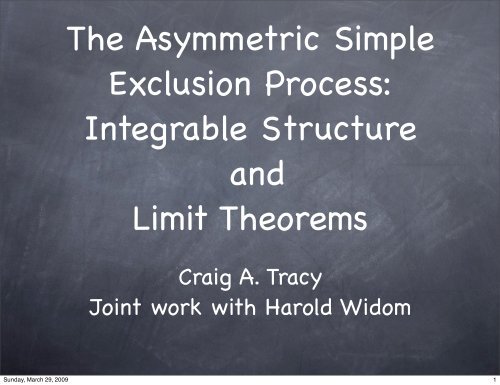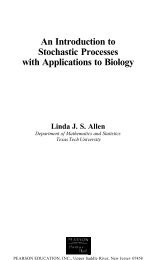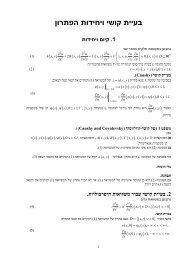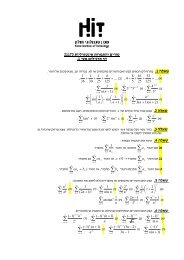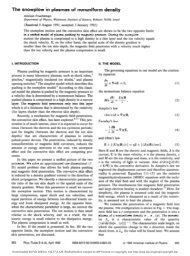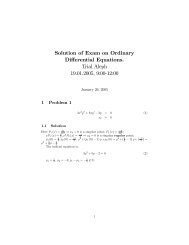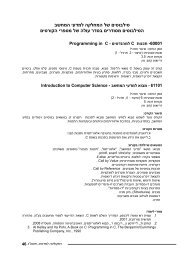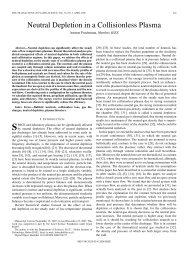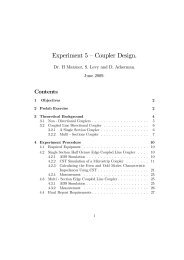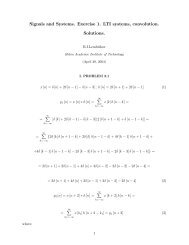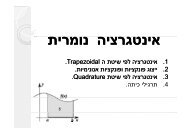Craig A. Tracy Joint work with Harold Widom
Craig A. Tracy Joint work with Harold Widom
Craig A. Tracy Joint work with Harold Widom
You also want an ePaper? Increase the reach of your titles
YUMPU automatically turns print PDFs into web optimized ePapers that Google loves.
The Asymmetric Simple<br />
Exclusion Process:<br />
Integrable Structure<br />
and<br />
Limit Theorems<br />
<strong>Craig</strong> A. <strong>Tracy</strong><br />
<strong>Joint</strong> <strong>work</strong> <strong>with</strong> <strong>Harold</strong> <strong>Widom</strong><br />
Sunday, March 29, 2009<br />
1
The asymmetric simple exclusion<br />
process (ASEP): Introduced in<br />
1970 by Frank Spitzer in<br />
“Interaction of Markov Processes.”<br />
The “default stochastic model for<br />
transport phenomena”. The ``Ising<br />
model of nonequilibrium<br />
phenomena’’.<br />
ASEP is a model for interacting<br />
particles on a lattice.<br />
Frank Spitzer<br />
Sunday, March 29, 2009<br />
2
ASEP on Integer Lattice<br />
q p<br />
<br />
p≠q<br />
Sunday, March 29, 2009<br />
3
ASEP on Integer Lattice<br />
q p<br />
<br />
p≠q<br />
●<br />
Each particle has an alarm clock --<br />
exponential distribution <strong>with</strong> parameter one<br />
Sunday, March 29, 2009<br />
3
ASEP on Integer Lattice<br />
q p<br />
<br />
p≠q<br />
●<br />
Each particle has an alarm clock --<br />
exponential distribution <strong>with</strong> parameter one<br />
●<br />
When alarm rings particle jumps to right <strong>with</strong><br />
probability p and to the left <strong>with</strong> probability q<br />
Sunday, March 29, 2009<br />
3
ASEP on Integer Lattice<br />
q p<br />
<br />
p≠q<br />
●<br />
Each particle has an alarm clock --<br />
exponential distribution <strong>with</strong> parameter one<br />
●<br />
When alarm rings particle jumps to right <strong>with</strong><br />
probability p and to the left <strong>with</strong> probability q<br />
●<br />
Jumps are suppressed if neighbor is occupied<br />
Sunday, March 29, 2009<br />
3
Initial Conditions<br />
Sunday, March 29, 2009<br />
4
Initial Conditions<br />
Step Initial Condition, q>p<br />
Sunday, March 29, 2009<br />
4
Initial Conditions<br />
Step Initial Condition, q>p<br />
Flat Initial Condition<br />
Sunday, March 29, 2009<br />
4
Initial Conditions<br />
Step Initial Condition, q>p<br />
Flat Initial Condition<br />
Random: Product Bernoulli measure<br />
Sunday, March 29, 2009<br />
4
Growth Processes & ASEP<br />
● ● ● ● ● ● ● ● ● ● ● ● ● ● ● ● ● ●<br />
● ● ● ● ● ● ● ● ● ● ● ● ● ● ● ● ●<br />
Sunday, March 29, 2009<br />
5
Growth Processes & ASEP<br />
● ● ● ● ● ● ● ● ● ● ● ● ● ● ● ● ● ●<br />
● ● ● ● ● ● ● ● ● ● ● ● ● ● ● ● ●<br />
Sunday, March 29, 2009<br />
5
KPZ Equation & Growth Processes<br />
❘<br />
❘<br />
↵<br />
Kardar, Parisi & Zhang<br />
(<br />
∂h<br />
∂t = ν ∂2 h ∂h<br />
∂x 2 + λ ∂x<br />
) 2<br />
+ w<br />
diffusion growth noise<br />
u(x, t) = ∂h<br />
∂x<br />
Noisy Burgers eqn<br />
Sunday, March 29, 2009<br />
6
Remarks<br />
Sunday, March 29, 2009<br />
7
• Physicists expect KPZ equation to describe a<br />
large class of stochastically growing interfaces:<br />
KPZ Universality<br />
Remarks<br />
Sunday, March 29, 2009<br />
7
• Physicists expect KPZ equation to describe a<br />
large class of stochastically growing interfaces:<br />
KPZ Universality<br />
Remarks<br />
• KPZ eqn mathematically difficult to handle so<br />
make discrete approximation in space<br />
Sunday, March 29, 2009<br />
7
• Physicists expect KPZ equation to describe a<br />
large class of stochastically growing interfaces:<br />
KPZ Universality<br />
Remarks<br />
• KPZ eqn mathematically difficult to handle so<br />
make discrete approximation in space<br />
• ASEP is one discrete version of KPZ; thus<br />
expect ``universal behavior’’ in limit theorems<br />
Sunday, March 29, 2009<br />
7
• Physicists expect KPZ equation to describe a<br />
large class of stochastically growing interfaces:<br />
KPZ Universality<br />
Remarks<br />
• KPZ eqn mathematically difficult to handle so<br />
make discrete approximation in space<br />
• ASEP is one discrete version of KPZ; thus<br />
expect ``universal behavior’’ in limit theorems<br />
• TASEP is ASEP <strong>with</strong> jumps only to left or jumps<br />
only to right. TASEP is a simpler model<br />
(determinantal process)<br />
Sunday, March 29, 2009<br />
7
Total Current I(x,t)<br />
Step Initial Condition<br />
Take q>p net drift to left<br />
I(x,t) = # of particles ≤ x at time t, x ≤ 0<br />
Let η(x,t)=1 if particle at x at time t<br />
otherwise 0<br />
so I(x,t)=∑ y≤x η(y,t)<br />
Sunday, March 29, 2009<br />
8
Current & Position of m th particle<br />
Sunday, March 29, 2009<br />
9
Current & Position of m th particle<br />
Step initial condition<br />
x m (t)=position of m th particle from<br />
left at time t, x m (0)=m<br />
Sunday, March 29, 2009<br />
9
Current & Position of m th particle<br />
Step initial condition<br />
x m (t)=position of m th particle from<br />
left at time t, x m (0)=m<br />
Event:<br />
{I(x,t)=m}={x m (t)≤x, x m+1 (t)>x}<br />
Sunday, March 29, 2009<br />
9
Current & Position of m th particle<br />
Step initial condition<br />
x m (t)=position of m th particle from<br />
left at time t, x m (0)=m<br />
Event:<br />
{I(x,t)=m}={x m (t)≤x, x m+1 (t)>x}<br />
From this and exclusion property:<br />
Prob(I(x,t)≤m) = 1-Prob(x m+1 (t)≤x)<br />
Sunday, March 29, 2009<br />
9
Integrable Structure of ASEP<br />
We solve the Kolmogorov<br />
forward equation (“master<br />
equation”) for the transition<br />
probability Y→X:<br />
P Y (X; t)<br />
Main idea comes from the<br />
Bethe Ansatz (1931)<br />
Hans Bethe in 1967<br />
Sunday, March 29, 2009<br />
10
N=1 ASEP<br />
probability q<br />
probability p<br />
● ● ● ● ● ● ● ● ● ●<br />
Let P Y (X;t)=probability Y→X at time t.<br />
Master equation:<br />
dP<br />
dt<br />
= pP(x − 1; t)+qP(x + 1; t) − P (x; t)<br />
∫<br />
P y (x; t) =<br />
ξ x−y−1 e tε(ξ) dξ<br />
C<br />
ε(ξ) = p ξ + q ξ − 1 11<br />
Sunday, March 29, 2009
N=2 ASEP<br />
● ● ● ● ● ● ● ● ● ● ● ● ● ● ● ●<br />
Master equation takes simple form for this configuration<br />
● ● ● ● ● ● ● ● ● ● ● ● ● ● ● ●<br />
Master equation reflects exclusion for this configuration<br />
Sunday, March 29, 2009<br />
12
N=2 ASEP<br />
● ● ● ● ● ● ● ● ● ● ● ● ● ● ● ●<br />
Master equation takes simple form for this configuration<br />
● ● ● ● ● ● ● ● ● ● ● ● ● ● ● ●<br />
Master equation reflects exclusion for this configuration<br />
Impose boundary conditions for first equation so<br />
that if satisfied the second equation is<br />
automatically satisfied --- Bethe’s Idea<br />
Sunday, March 29, 2009<br />
12
Important Point<br />
New boundary conditions arise for N=3, 4,...<br />
◦ ◦ ◦ ◦ ◦ ◦ ◦ ◦ ◦ ◦ ◦ ◦<br />
◦ ◦ ◦ ◦ ◦ ◦ ◦ ◦ ◦ ◦ ◦ ◦<br />
◦ ◦ ◦ ◦ ◦ ◦ ◦ ◦ ◦ ◦ ◦ ◦<br />
◦ ◦ ◦ ◦ ◦ ◦ ◦ ◦ ◦ ◦ ◦ ◦<br />
Last configuration requires new BC --<br />
automatically satisfied by 2-particle BC<br />
Sunday, March 29, 2009<br />
13
Bethe Ansatz Solution of Master<br />
Equation<br />
Sunday, March 29, 2009<br />
14
Bethe Ansatz Solution of Master<br />
Equation<br />
For any ξ 1 ,...,ξ N ∈ C\{0} and any permutation<br />
σ a solution is<br />
∏<br />
j<br />
ξ x j<br />
σ(j) etε(ξ j)<br />
Sunday, March 29, 2009<br />
14
Bethe Ansatz Solution of Master<br />
Equation<br />
For any ξ 1 ,...,ξ N ∈ C\{0} and any permutation<br />
σ a solution is<br />
∏<br />
j<br />
ξ x j<br />
σ(j) etε(ξ j)<br />
Can take linear combination or integral of<br />
a linear combination & have a solution:<br />
∫ ∑<br />
∏<br />
e tε(ξj) d N ξ<br />
σ∈S N<br />
F σ (ξ) ∏ j<br />
ξ x j<br />
σ(j)<br />
j<br />
Sunday, March 29, 2009<br />
14
Remarks<br />
Sunday, March 29, 2009<br />
15
Remarks<br />
• Want BC to be satisfied. Bethe’s idea: This<br />
can be applied pointwise to the integrand<br />
Sunday, March 29, 2009<br />
15
Remarks<br />
• Want BC to be satisfied. Bethe’s idea: This<br />
can be applied pointwise to the integrand<br />
• Gives condition on coefficients <strong>with</strong> result<br />
(this part same as the Yang & Yang analysis<br />
of XXZ spin Hamiltonian). If<br />
A σ = sgn(σ)<br />
∏<br />
i
Remarks<br />
• Want BC to be satisfied. Bethe’s idea: This<br />
can be applied pointwise to the integrand<br />
• Gives condition on coefficients <strong>with</strong> result<br />
(this part same as the Yang & Yang analysis<br />
of XXZ spin Hamiltonian). If<br />
A σ = sgn(σ)<br />
∏<br />
i
Remarks<br />
Sunday, March 29, 2009<br />
16
Remarks<br />
• To recap: We have found a solution to the<br />
master equation satisfying the BCs.<br />
Sunday, March 29, 2009<br />
16
Remarks<br />
• To recap: We have found a solution to the<br />
master equation satisfying the BCs.<br />
• Must show the solution at X={x 1 ,...x N } & t=0<br />
reduces to δ X,Y where Y={y 1 ,...,y N } is the initial<br />
configuration of N particles.<br />
Sunday, March 29, 2009<br />
16
Remarks<br />
• To recap: We have found a solution to the<br />
master equation satisfying the BCs.<br />
• Must show the solution at X={x 1 ,...x N } & t=0<br />
reduces to δ X,Y where Y={y 1 ,...,y N } is the initial<br />
configuration of N particles.<br />
• Term for σ=id satisfies initial condition. Must<br />
show remaining N!-1 terms give zero at t=0.<br />
This is the new part of the problem.<br />
Sunday, March 29, 2009<br />
16
Remarks<br />
• To recap: We have found a solution to the<br />
master equation satisfying the BCs.<br />
• Must show the solution at X={x 1 ,...x N } & t=0<br />
reduces to δ X,Y where Y={y 1 ,...,y N } is the initial<br />
configuration of N particles.<br />
• Term for σ=id satisfies initial condition. Must<br />
show remaining N!-1 terms give zero at t=0.<br />
This is the new part of the problem.<br />
• Have not yet specified the contours.<br />
Sunday, March 29, 2009<br />
16
Theorem (TW): If p ≠ 0 and r is small enough then<br />
P Y (X; t) = ∑<br />
σ∈S N<br />
∫C N r<br />
A σ (ξ) ∏ i<br />
ξ x i<br />
σ(i)<br />
∏<br />
i<br />
(<br />
ξ −y i−1<br />
i e ε(ξ i) t ) d N ξ.<br />
where<br />
and satisfies<br />
A σ = sgn σ<br />
∏<br />
i
Marginal Distributions<br />
P(x m (t)≤x)<br />
Sunday, March 29, 2009<br />
18
Marginal Distributions<br />
P(x m (t)≤x)<br />
Case m=1:<br />
Fix x 1 =x, sum P Y (X;t) over allowed x 2 , x 3 , x 4 ,...<br />
Can do this since contours are small: |ξ i |< 1<br />
Sunday, March 29, 2009<br />
18
Marginal Distributions<br />
P(x m (t)≤x)<br />
Case m=1:<br />
Fix x 1 =x, sum P Y (X;t) over allowed x 2 , x 3 , x 4 ,...<br />
Can do this since contours are small: |ξ i |< 1<br />
Result is an expression involving N! terms. Use<br />
first miraculous identity to reduce sum to one<br />
term!<br />
Here’s the identity:<br />
Sunday, March 29, 2009<br />
18
First Identity<br />
∑<br />
sgn σ<br />
⎛<br />
⎝ ∏ i
• Using this identity we get for m=1 an<br />
expression for P(x 1 (t)≤x) as a single N-<br />
dimensional integral <strong>with</strong> a product<br />
integrand. This expression is for finite-N<br />
ASEP<br />
I(x, Y, ξ) = ∏ i
Prob(x 1 (t)=x) =<br />
∫<br />
p N(N−1)/2 ∫C r<br />
· · ·<br />
C r<br />
I(x, Y, ξ) dξ 1 · · · dξ N<br />
(p ≠ 0)<br />
Sunday, March 29, 2009<br />
21
Prob(x 1 (t)=x) =<br />
∫<br />
p N(N−1)/2 ∫C r<br />
· · ·<br />
C r<br />
I(x, Y, ξ) dξ 1 · · · dξ N<br />
(p ≠ 0)<br />
• Sum of N! integrals reduced to one integral<br />
Sunday, March 29, 2009<br />
21
Prob(x 1 (t)=x) =<br />
∫<br />
p N(N−1)/2 ∫C r<br />
· · ·<br />
C r<br />
I(x, Y, ξ) dξ 1 · · · dξ N<br />
(p ≠ 0)<br />
• Sum of N! integrals reduced to one integral<br />
• Form is not so useful to take N→∞<br />
Sunday, March 29, 2009<br />
21
Prob(x 1 (t)=x) =<br />
∫<br />
p N(N−1)/2 ∫C r<br />
· · ·<br />
C r<br />
I(x, Y, ξ) dξ 1 · · · dξ N<br />
(p ≠ 0)<br />
• Sum of N! integrals reduced to one integral<br />
• Form is not so useful to take N→∞<br />
• We now expand contour outwards -- only<br />
residues that contribute come from ξ i =1.<br />
Sunday, March 29, 2009<br />
21
Prob(x 1 (t)=x) =<br />
∫<br />
p N(N−1)/2 ∫C r<br />
· · ·<br />
C r<br />
I(x, Y, ξ) dξ 1 · · · dξ N<br />
(p ≠ 0)<br />
• Sum of N! integrals reduced to one integral<br />
• Form is not so useful to take N→∞<br />
• We now expand contour outwards -- only<br />
residues that contribute come from ξ i =1.<br />
• Can take N→∞ in resulting expression to<br />
obtain<br />
Sunday, March 29, 2009<br />
21
σ(S) : = ∑ i∈S<br />
i<br />
∑<br />
P(x 1 (t) =x) =<br />
S<br />
∫<br />
p σ(S)−|S|<br />
q σ(S)−|S|(|S|+1)/2 ×<br />
∫<br />
C R<br />
· · ·<br />
C R<br />
I(x, Y S , ξ) d |S| ξ<br />
The sum is over all nonempty subsets of Z<br />
When p=0 only one term is nonzero, S={1}.<br />
Sunday, March 29, 2009<br />
22
Remarks<br />
Sunday, March 29, 2009<br />
23
Remarks<br />
• To go beyond the left-most particle, m=1,<br />
there are new complications<br />
Sunday, March 29, 2009<br />
23
Remarks<br />
• To go beyond the left-most particle, m=1,<br />
there are new complications<br />
• These come from the fact that we must<br />
sum over all x j > x m and all x i < x m .<br />
Some contours must be small (former)<br />
and some must be large (latter) to<br />
obtain convergence of geometric series<br />
Sunday, March 29, 2009<br />
23
Remarks<br />
• To go beyond the left-most particle, m=1,<br />
there are new complications<br />
• These come from the fact that we must<br />
sum over all x j > x m and all x i < x m .<br />
Some contours must be small (former)<br />
and some must be large (latter) to<br />
obtain convergence of geometric series<br />
• This involves finding a new identity<br />
Sunday, March 29, 2009<br />
23
Second Identity<br />
S ranges over subsets of {1, 2, . . . , N}<br />
∑<br />
|S|=m<br />
∏<br />
p + qξ i ξ j − ξ i<br />
ξ j − ξ i<br />
i∈S, j∈S c<br />
· (1 − ∏<br />
j∈S c ξ j )<br />
= q m [ N<br />
m<br />
]<br />
(1 −<br />
N∏<br />
ξ j ).<br />
j=1<br />
[N] = pN − q N<br />
p − q<br />
[ ] N [N]!<br />
=<br />
m<br />
, [N]! = [N][N − 1] · · · [1],<br />
[m]! [N − m]! , (q − binomial coefficient), 24<br />
Sunday, March 29, 2009
Final series result for case Y = Z +<br />
P (x m (t) ≤ x) = (−1) ∑ m k≥m<br />
∫ ∫<br />
× · · ·<br />
C R<br />
× ∏ i<br />
1<br />
k!<br />
[ ] k − 1<br />
k − m<br />
τ<br />
p (k−m)(k−m+1)/2 q km+(k−m)(k+m−1)/2<br />
∏ ξ j − ξ i<br />
∏ 1<br />
C R<br />
p + qξ i ξ j − ξ i (1 − ξ<br />
i≠j<br />
i i )(qξ i − p)<br />
( ) ξi x e ε(ξ i)t<br />
dξ 1 · · · dξ k<br />
25<br />
Sunday, March 29, 2009
Final series result for case Y = Z +<br />
P (x m (t) ≤ x) = (−1) ∑ m k≥m<br />
∫ ∫<br />
× · · ·<br />
C R<br />
× ∏ i<br />
1<br />
k!<br />
C R<br />
∏<br />
[ ] k − 1<br />
k − m<br />
τ<br />
i≠j<br />
p (k−m)(k−m+1)/2 q km+(k−m)(k+m−1)/2<br />
ξ j − ξ i<br />
∏<br />
p + qξ i ξ j − ξ i<br />
(<br />
ξ x i e ε(ξ i)t ) dξ 1 · · · dξ k<br />
i<br />
1<br />
(1 − ξ i )(qξ i − p)<br />
● For p=0 only k=m term is nonzero<br />
Sunday, March 29, 2009<br />
25
Final series result for case Y = Z +<br />
P (x m (t) ≤ x) = (−1) ∑ m k≥m<br />
∫ ∫<br />
× · · ·<br />
C R<br />
× ∏ i<br />
1<br />
k!<br />
C R<br />
∏<br />
[ ] k − 1<br />
k − m<br />
τ<br />
i≠j<br />
p (k−m)(k−m+1)/2 q km+(k−m)(k+m−1)/2<br />
ξ j − ξ i<br />
∏<br />
p + qξ i ξ j − ξ i<br />
(<br />
ξ x i e ε(ξ i)t ) dξ 1 · · · dξ k<br />
i<br />
1<br />
(1 − ξ i )(qξ i − p)<br />
● For p=0 only k=m term is nonzero<br />
• Recognize double product as a determinant<br />
whose entries are a kernel, i.e. K(ξ i ,ξ j )<br />
Sunday, March 29, 2009<br />
25
Final series result for case Y = Z +<br />
P (x m (t) ≤ x) = (−1) ∑ m k≥m<br />
∫ ∫<br />
× · · ·<br />
C R<br />
× ∏ i<br />
1<br />
k!<br />
C R<br />
∏<br />
[ ] k − 1<br />
k − m<br />
τ<br />
i≠j<br />
p (k−m)(k−m+1)/2 q km+(k−m)(k+m−1)/2<br />
ξ j − ξ i<br />
∏<br />
p + qξ i ξ j − ξ i<br />
(<br />
ξ x i e ε(ξ i)t ) dξ 1 · · · dξ k<br />
i<br />
1<br />
(1 − ξ i )(qξ i − p)<br />
● For p=0 only k=m term is nonzero<br />
• Recognize double product as a determinant<br />
whose entries are a kernel, i.e. K(ξ i ,ξ j )<br />
• Result can then be expressed as a contour<br />
integral whose integrand is a Fredholm<br />
determinant<br />
Sunday, March 29, 2009<br />
25
Fredholm determinant<br />
• Let K(x,y) be a kernel function<br />
• Fredholm expansion of det(I-λK):<br />
(−1) n<br />
n!<br />
∫<br />
· · ·<br />
∫<br />
det (K(ξ i , ξ j ) 1≤i,j≤n<br />
dξ 1 · · · dξ n =<br />
∫<br />
C<br />
det (I − λK)<br />
dλ<br />
λ n+1<br />
•Can then do sum over k (q-Binomial theorem):<br />
Sunday, March 29, 2009<br />
26
Final expression for m th particle distribution fn.<br />
Step initial condition<br />
Set γ = q − p>0, τ = q/p and<br />
define an integral operator K on<br />
circle C R :<br />
Then<br />
K(ξ, ξ ′ )=q ξ′x e tε(ξ′ )/γ<br />
p + qξξ ′ − ξ<br />
P (x m (t/γ) ≤ x) =<br />
∫<br />
det(I − λK)<br />
∏ m−1<br />
k=0 (1 − λτ k−1 )<br />
The contour in the λ-plane encloses<br />
all of the singularities of<br />
the integrand.<br />
dλ<br />
λ<br />
↑ k-1→k<br />
Sunday, March 29, 2009<br />
27
Asymptotic analysis<br />
We now transform the operator<br />
K so that we can perform a<br />
steepest descent analysis.<br />
Recall that the generic behavior<br />
for the coalescence of two saddle<br />
points leads to the Airy function<br />
Ai(x)<br />
George Airy<br />
Sunday, March 29, 2009<br />
28
ξ −→ 1 − τη<br />
1 − η , τ = p q < 1,<br />
K(ξ, ξ ′ ) −→ K 2 (η, η ′ )= ϕ(η′ )<br />
η ′ − τη<br />
ϕ(η) =<br />
( 1 − τη<br />
1 − η<br />
) x<br />
e [ 1<br />
1−η − 1<br />
1−τη]<br />
t<br />
Introduce: K 1 (η, η ′ ) = ϕ(τη)<br />
η ′ − τη<br />
Sunday, March 29, 2009<br />
29
Two Preliminary Results<br />
Sunday, March 29, 2009<br />
30
Two Preliminary Results<br />
Proposition:<br />
Let Γ be any closed curve going around η=1<br />
once counterclockwise <strong>with</strong> η=1/τ on the<br />
outside. Then the Fredholm determinant of<br />
K(ξ,ξ’) acting on C R has the same Fredholm<br />
determinant as K 1 (η,η’)-K 2 (η,η’) acting on Γ.<br />
Sunday, March 29, 2009<br />
30
Two Preliminary Results<br />
Proposition:<br />
Let Γ be any closed curve going around η=1<br />
once counterclockwise <strong>with</strong> η=1/τ on the<br />
outside. Then the Fredholm determinant of<br />
K(ξ,ξ’) acting on C R has the same Fredholm<br />
determinant as K 1 (η,η’)-K 2 (η,η’) acting on Γ.<br />
Proposition:<br />
Suppose the contour Γ is star-shaped <strong>with</strong><br />
respect to η=0. Then the Fredholm<br />
determinant of K 1 acting on Γ is equal to<br />
∞∏<br />
Sunday, March 29, 2009<br />
k=0<br />
(1 − λτ k )<br />
30
Denote by R the resolvent kernel of K 1<br />
Factor determinant:<br />
det(I-λ K)=det(I-λ K 1 ) det(I+K 2 (I+R))<br />
Set λ=τ -m μ so formula for distr. fn becomes<br />
∫<br />
∞<br />
∏<br />
k=0<br />
(1 − µτ k ) det ( I + τ −m µK 2 (I + R) ) dµ<br />
µ<br />
μ runs over a circle of radius > τ<br />
Sunday, March 29, 2009<br />
31
By a perturbative expansion of R, followed<br />
by a deformation of operators, we show<br />
det (I + λK 2 (I + R)) = det (I + µJ)<br />
∫<br />
J(η, η ′ ϕ∞ (ζ) ζ m f(µ, ζ/η ′ )<br />
) =<br />
ϕ ∞ (η ′ ) (η ′ ) m+1 ζ − η<br />
ϕ ∞ (η) = (1 − η) −x e ηt<br />
1−η<br />
f(µ, z) =<br />
∞∑<br />
k=−∞<br />
τ k<br />
1 − τ k µ zk<br />
dζ<br />
The kernel J(η,η’), which acts on a circle centered<br />
at 0 <strong>with</strong> radius less than τ, is analyzed by the<br />
steepest descent method.<br />
Note: m now appears inside the kernel!<br />
Sunday, March 29, 2009<br />
32
Main Result<br />
We set<br />
σ = m t ,c 1 = −1+2 √ σ,c 2 = σ −1/6 (1− √ σ) 2/3 , γ = q−p<br />
Theorem (TW). When 0 ≤ p
Total Current Fluctuations<br />
I(x,t) = # of particles ≤ x at time t, x ≤0<br />
Theorem.<br />
( I([−vt], t/γ) − a1<br />
lim P t<br />
t→∞ a 2 t 1/3<br />
≤ s<br />
)<br />
=1− F 2 (−s)<br />
where<br />
0 ≤ v
Remarks<br />
Sunday, March 29, 2009<br />
35
Remarks<br />
• Theorems generalize Kurt Johansson’s results<br />
for TASEP to ASEP.<br />
Sunday, March 29, 2009<br />
35
Remarks<br />
• Theorems generalize Kurt Johansson’s results<br />
for TASEP to ASEP.<br />
• Coefficients a 1 & c 1 known since 1980s, Liggett,<br />
Rost.<br />
Sunday, March 29, 2009<br />
35
Remarks<br />
• Theorems generalize Kurt Johansson’s results<br />
for TASEP to ASEP.<br />
• Coefficients a 1 & c 1 known since 1980s, Liggett,<br />
Rost.<br />
• These theorems establish KPZ Universality at<br />
the fluctuation level for ASEP.<br />
Sunday, March 29, 2009<br />
35
Remarks<br />
• Theorems generalize Kurt Johansson’s results<br />
for TASEP to ASEP.<br />
• Coefficients a 1 & c 1 known since 1980s, Liggett,<br />
Rost.<br />
• These theorems establish KPZ Universality at<br />
the fluctuation level for ASEP.<br />
• Balázs & Seppäläinen; Quastel & Valkó prove<br />
t ⅓ fluctuations for ASEP <strong>with</strong> Bernoulli product<br />
initial condition -- general probabilistic<br />
methods<br />
Sunday, March 29, 2009<br />
35
Sunday, March 29, 2009<br />
36
● Would like a conceptual understanding of why identities<br />
& cancellations appear in ASEP proofs.<br />
Sunday, March 29, 2009<br />
36
● Would like a conceptual understanding of why identities<br />
& cancellations appear in ASEP proofs.<br />
● Extend ASEP results to other initial conditions, e.g.<br />
flat initial conditions. Do we see F 1 as in TASEP?<br />
Sunday, March 29, 2009<br />
36
● Would like a conceptual understanding of why identities<br />
& cancellations appear in ASEP proofs.<br />
● Extend ASEP results to other initial conditions, e.g.<br />
flat initial conditions. Do we see F 1 as in TASEP?<br />
● Can we apply Bethe Ansatz methods to other growth<br />
models?<br />
Sunday, March 29, 2009<br />
36
● Would like a conceptual understanding of why identities<br />
& cancellations appear in ASEP proofs.<br />
● Extend ASEP results to other initial conditions, e.g.<br />
flat initial conditions. Do we see F 1 as in TASEP?<br />
● Can we apply Bethe Ansatz methods to other growth<br />
models?<br />
● Ultimately we want universality theorems not to rely<br />
upon integrable stucture of ASEP. For ⅓ exponent<br />
progress by Balázs, Seppäläinen, Quastel & Valkó.<br />
Sunday, March 29, 2009<br />
36
Thanks to Anne Schilling & Doron Zeilberger<br />
for advice <strong>with</strong> the combinatorial identities<br />
Sunday, March 29, 2009<br />
37


